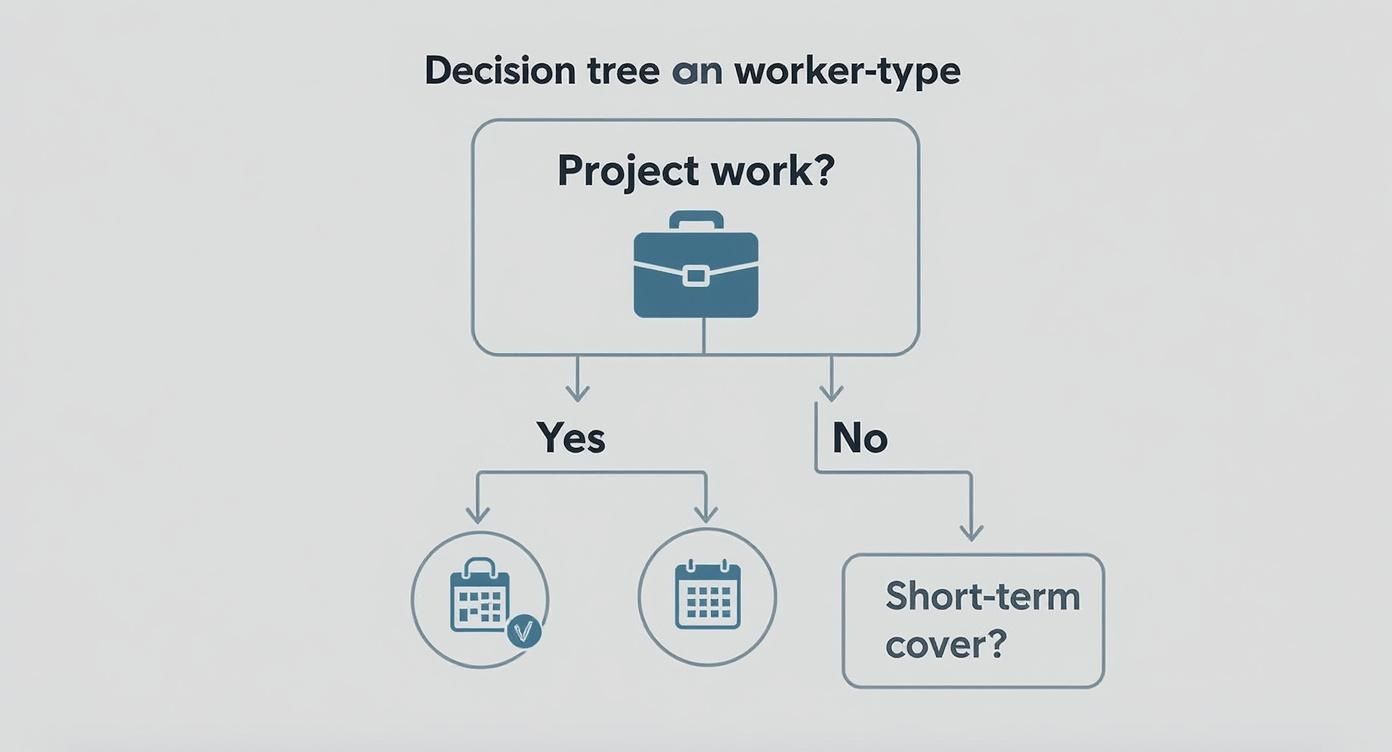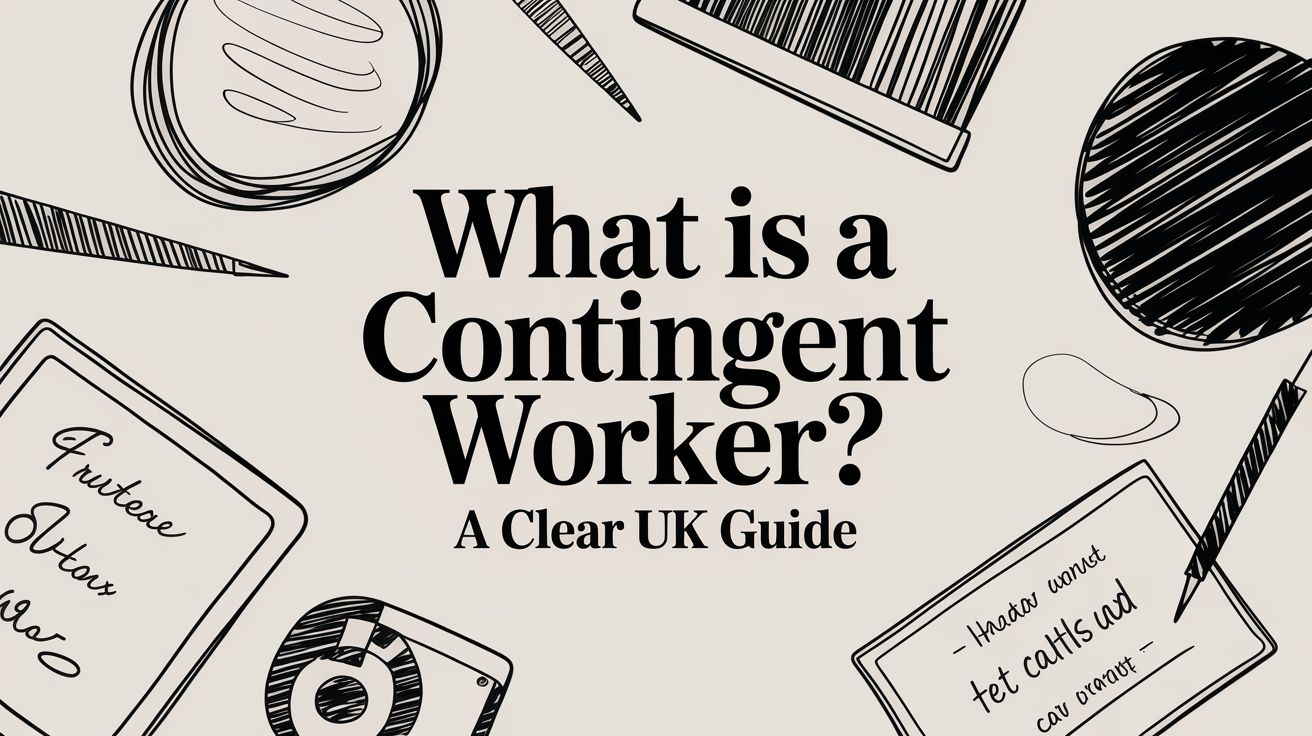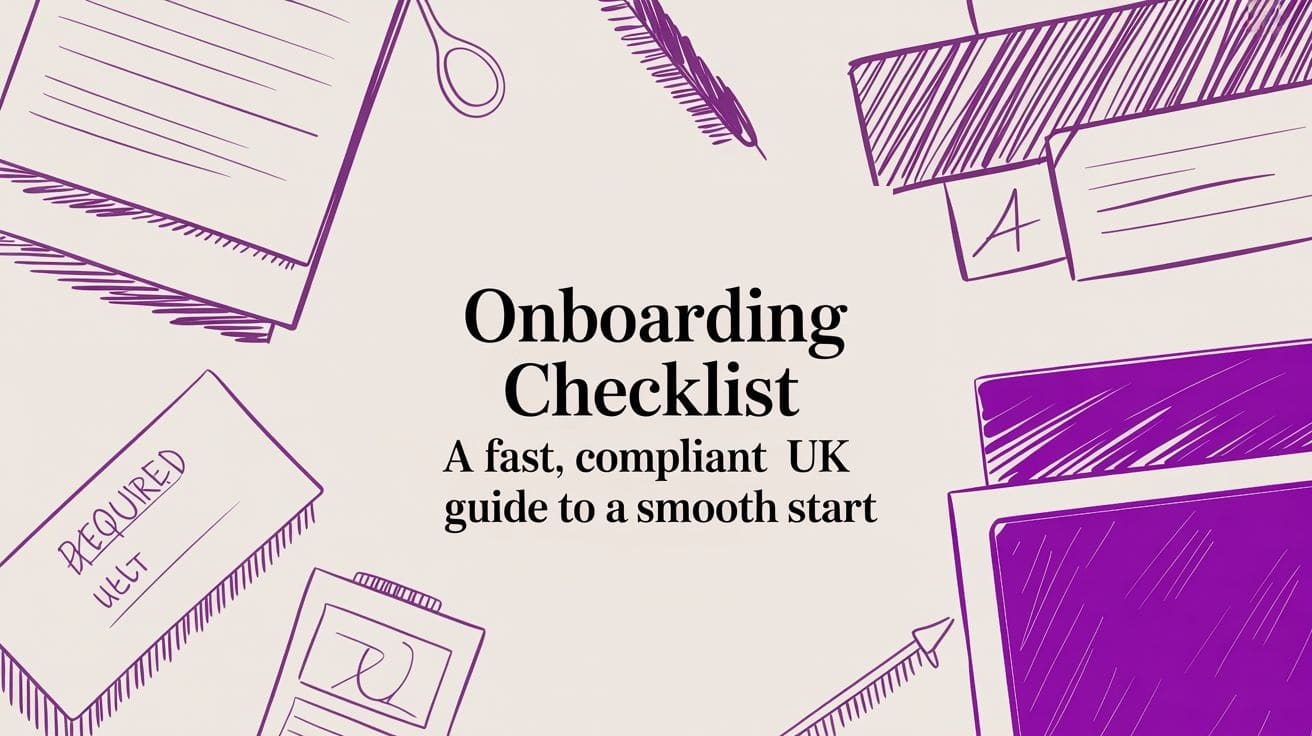You’ve probably heard the term contingent worker floating around, but what does it actually mean in practice? Simply put, a contingent worker is anyone who works for your business on a non-permanent basis. Think of them as specialists you bring in for a specific project or a defined period, rather than as full-time crew members.
What a Contingent Worker Really Means for Your Business

Let’s use an example. Imagine your company wants to launch a new mobile app. The traditional route would involve hiring a full-time team of developers, designers, and a project manager, which means lengthy recruitment processes and fixed payroll costs. The alternative? You could bring together a hand-picked team of independent contractors and freelancers just for this project. That’s the contingent workforce in action.
These individuals operate outside your standard employment framework. They aren’t on your company payroll, they don’t get employee benefits like pensions or paid holidays, and they handle their own taxes. For businesses, this model provides incredible flexibility, allowing you to scale your team up or down based on project needs or even seasonal demand.
The Rise of the Flexible Workforce
Temporary work isn’t a new idea, but its strategic importance and sheer scale have exploded in recent years. In fact, as of 2025, nearly 20% of the UK workforce falls into the contingent category. This includes around 1.4 million temporary workers and another 4.38 million self-employed individuals—a vast talent pool ranging from gig economy drivers to elite consultants. For more detail on these figures, you can explore the modern workforce breakdown on CenturoGlobal.com.
This shift is happening for two key reasons:
- Businesses need to be more agile: In a fast-moving market, companies need to adapt quickly. Contingent workers offer access to specialised skills on-demand, without the long-term overheads of a permanent hire.
- Professionals want more control: Many modern workers, especially younger ones, prioritise flexibility and autonomy. The freedom of freelance or contract work is a powerful draw compared to a traditional nine-to-five.
A contingent worker is anyone who provides services to your organisation without being a permanent, salaried employee. They are engaged for a specific outcome, project, or period, giving you access to specialised skills precisely when you need them.
Why This Distinction Matters
Getting the definition right is more than just semantics; it’s critical for effective workforce management and, crucially, for legal compliance. Misclassifying a worker can lead to serious financial penalties and legal headaches, particularly with UK regulations like IR35 looming large.
This guide will give you a clear path forward. We’ll break down the different types of contingent workers, demystify the complex UK legal landscape, and set out best practices for managing this dynamic talent pool. By the end, you’ll have the insights needed to build a flexible, efficient, and compliant workforce strategy that truly supports your business goals.
Exploring the Types of Contingent Workers
The term ‘contingent worker’ isn’t a one-size-fits-all label. It’s more of an umbrella term that covers a whole spectrum of professional arrangements. Getting to grips with these different types is your first real step toward building a workforce strategy that’s genuinely flexible, because each one serves a different purpose and comes with its own contractual rules.
Think of it like putting together a specialist team for a one-off mission. You wouldn’t hire a full-time demolitions expert just to take down a single wall. You’d bring in a pro for that specific task and that’s it. The same logic applies to your workforce. Picking the right kind of contingent talent really boils down to the job you need doing.
Independent Contractors and Freelancers
When people think of contingent workers, independent contractors and freelancers are usually the first to come to mind. These are self-employed individuals—true masters of their craft—who offer specialised services on a project-by-project basis. You bring them in to achieve a very specific outcome.
A classic example? A marketing agency hiring a freelance UX designer to overhaul a client’s clunky mobile app. The designer is brought on for that project alone, uses their own tools, sets their own working hours, and sends an invoice when the job is done. Their relationship with the agency is governed by a contract for services, not a contract of employment.
This approach gives businesses direct access to incredible skills without the long-term overheads of a permanent employee. In fact, a 2023 study showed that 51% of business leaders are planning to use more contingent workers, driven precisely by this need for on-demand expertise.
Temporary Agency Workers
Often called ‘temps’, temporary agency workers fill a different, but just as vital, gap. These workers are actually employed by a staffing agency, which then places them with businesses to cover short-term needs. It’s the go-to solution for dealing with seasonal rushes or covering for an employee on long-term leave.
Picture a retail store during the manic Christmas period. To handle the crowds, they might bring in a handful of temporary staff from a local agency. The store manager directs their day-to-day work, but the agency is the one responsible for their payroll, PAYE tax deductions, and National Insurance contributions.
This setup is a fantastic way to get boots on the ground quickly while offloading a huge chunk of the admin onto the agency.
Understanding the contractual chain is crucial. With a freelancer, you have a direct contract with them. With an agency worker, your contract is with the agency—the actual employer—creating a three-way relationship between you, the agency, and the worker.
Consultants and Statement of Work Providers
At the more strategic end of the spectrum, you have consultants. These are typically seasoned experts or specialised firms you engage to provide high-level advice, untangle complex business problems, or deliver a project defined by a Statement of Work (SoW).
Let’s say a company is gearing up for a major digital upgrade. They might hire an IT consultancy to map out the strategy and oversee the first phase. The SoW document is key here—it will lay out the project’s exact scope, deliverables, timelines, and payment milestones, leaving no room for ambiguity about what success looks like.
This category also includes outsourced service providers, where you hand over an entire business function, like your payroll or IT helpdesk, to a third-party specialist. It’s a way for a company to stay lean while still benefiting from professional-grade services.
To make these distinctions crystal clear, here’s a simple breakdown:
| Worker Type | Primary Use Case | Contractual Relationship | Payment Structure |
|---|---|---|---|
| Freelancer | Project-specific skills (e.g., writing, design) | Direct contract with the individual | Per project or per hour |
| Agency Temp | Covering absence or seasonal peaks | Contract with the staffing agency | Hourly rate paid via agency |
| Consultant | Strategic advice or project delivery | Direct contract or SoW with an expert/firm | Retainer, project fee, or day rate |
Each of these roles provides a unique way to bring fresh expertise and agility into your organisation. By understanding what a contingent worker is in all its forms, you can start making smarter, more strategic decisions about getting the right talent, at the right time, and under the right terms. This groundwork is essential before we dive into the legal maze of compliance.
Navigating UK Compliance and IR35 Rules
Bringing a contingent worker on board is more than just a handshake and a contract. It means stepping into a complex web of UK legal responsibilities. Getting this right is crucial; it protects your business from some pretty hefty financial penalties and reputational fallout. You really have to treat compliance for a contractor with the same rigour as you would for any permanent hire.
The whole legal framework is there to ensure everyone gets a fair deal and to clamp down on tax avoidance. But make no mistake, the burden of responsibility falls squarely on you, the company doing the hiring. That means you need to be proactive from day one—determining their employment status, verifying their right to work in the UK, and sorting out your data protection duties.
Demystifying IR35 Off-Payroll Working Rules
For most UK businesses, the biggest compliance headache is the IR35 legislation, often called the off-payroll working rules. At its heart, IR35 is all about figuring out one key thing: is this contractor a genuine business-to-business supplier, or are they what HMRC calls a ‘disguised employee’ for tax purposes?
If the working relationship looks and feels like employment, the contractor is deemed ‘inside IR35’. This is a big deal because it makes you, the client, responsible for deducting Income Tax and National Insurance Contributions (NICs) just as if they were on your payroll. If they’re genuinely self-employed, they fall ‘outside IR35’, and you can pay them their gross fee.
Getting this call wrong can be costly. HMRC keeps a close eye on worker misclassification, and the penalties are not to be taken lightly. As the contingent workforce grows, the rules are only getting more complex. In fact, recent changes have pushed compliance costs up, with penalties for getting it wrong potentially exceeding £25,000 per case in the UK. For more on this, check out these 2025 contingent workforce trends on indeedflex.co.uk.
The responsibility for making this determination sits firmly with you. You have to issue a Status Determination Statement (SDS) to both the worker and any agency involved, clearly explaining your decision and the reasoning behind it.
This decision tree gives you a high-level view of the questions you should be asking to see if a contingent worker is the right choice for a particular need.

Thinking through this flow helps you separate bringing in a specialist for a defined project from hiring a temp for general cover—a critical distinction for working out their IR35 status.
Core Compliance Responsibilities You Cannot Ignore
Beyond the maze of IR35, there are several other non-negotiable duties you need to handle when you engage a contingent worker. Each one is a vital piece of the puzzle for building a legally sound and flexible workforce.
- Right to Work Checks: This is a fundamental legal requirement for everyone, not just your permanent staff. Before they do a single day’s work, you must verify that every individual, from a freelance consultant to an agency temp, has the legal right to work in the UK. The fines for failing to do this are severe, and it can even lead to criminal charges.
- Data Protection and GDPR: Contingent workers often need access to sensitive company or customer data. Your responsibilities under GDPR extend to them, too. They must understand and follow your data protection policies, and their contract needs to have crystal-clear clauses on confidentiality and data security.
- Payroll and Payment Structures: The way you pay a contingent worker is a key detail. Paying a freelancer’s limited company is a straightforward business-to-business transaction. But if a worker is inside IR35, things change. You’ll likely need to route their payment through an umbrella company or even your own payroll to ensure the right tax is deducted at source.
The key thing to remember is that compliance isn’t a one-and-done task. It’s an ongoing process. From the moment you decide their status to the day their contract ends, every stage of the contingent worker’s journey with you needs to be managed with the law in mind.
Staying Ahead of Regulatory Changes
The legal landscape is always shifting. Rules on worker classification and employment rights are constantly being updated, which means businesses have to stay on their toes. For HR and IT leaders, this means putting solid internal processes in place and using technology to manage these obligations without dropping the ball. Keeping up-to-date isn’t just good practice—it’s essential for managing risk.
To keep learning about this topic, you can explore our detailed guides and articles covering UK compliance requirements on DynamicsHub. Having a solid grip on these rules will give you the confidence to build a flexible workforce that is both effective and on firm legal ground.
Best Practices for Managing Contingent Talent

Managing contingent workers effectively is more than just ticking legal boxes. It’s about transforming a temporary arrangement from a simple transaction into a genuine strategic advantage. To get the most out of your flexible talent, you need a clear playbook for their entire journey with you, from the initial contract to the final invoice.
When you treat contingent workers as valued partners—while always respecting the contractual boundaries—you unlock their full potential. A well-run programme not only gets you better results but also builds a strong reputation, making your company a magnet for top-tier freelance and contract talent for future projects.
This has never been more critical. With 65% of UK employers reporting struggles to fill skilled roles in 2023, flexible talent has become a vital solution to bridge skills gaps. In fact, temporary workers now make up around 6% of the UK workforce, proving just how essential they’ve become. You can find more details on these UK contingent staffing trends on staffnow.uk.
Create a Seamless Onboarding Process
First impressions count, even for a three-month contract. A clunky, disorganised onboarding experience is a recipe for confusion and wasted time. The aim is to get your contingent worker up to speed and productive as quickly as possible, which calls for a dedicated process that’s separate from your standard employee onboarding.
This process should equip them with everything they need to hit the ground running, without blurring the lines of employment. Focus on clear project briefs, access to the right systems, and introductions to key team members. Critically, you should avoid including them in company-wide inductions or orientations meant for permanent staff.
A simple checklist is the best tool to keep the process consistent and ensure no crucial steps are missed. Here’s a look at how HR and IT can work together to get it right.
HR and IT Onboarding Checklist for Contingent Workers
To make sure every onboarding is smooth and compliant, a shared checklist helps both departments stay aligned. This ensures nothing falls through the cracks, from legal checks to system access.
| Department | Task | Key Consideration |
|---|---|---|
| HR | Verify Right to Work & Contract | All legal paperwork must be signed and filed before any work begins. This is non-negotiable. |
| HR | Provide Project Brief & Contacts | Clearly outline the project goals, deliverables, and who their main point of contact is. |
| IT | Provision System Access | Grant time-limited access only to the systems and data required for their specific project. |
| IT | Issue Temporary Equipment | If you’re providing a laptop or phone, log the assets and set a clear return date. |
| HR | Explain Invoicing & Payment Process | Communicate exactly how and when to submit invoices to prevent payment delays and frustration. |
| IT | Outline Security Protocols | Ensure the worker understands and formally agrees to your data security and confidentiality policies. |
Following a structured list like this not only makes the process more efficient but also reinforces the professional, project-based nature of the relationship from day one.
Integrate Without Misclassifying
Making a contingent worker feel part of the team—without actually treating them like an employee—is one of the trickiest parts of the job. You need them integrated enough to collaborate effectively, but you must handle it carefully to avoid misclassification risks under rules like IR35.
The key is to focus on professional collaboration, not cultural immersion.
- Involve them in project-specific meetings: This is essential for keeping everyone aligned and the project on track.
- Use dedicated communication channels: A project-specific channel in Microsoft Teams or Slack keeps all communication focused and relevant.
- Avoid company-wide social events: Invitations to the Christmas party or team-building away days can imply an employment relationship.
- Provide feedback on deliverables, not performance: Frame your conversations around the quality of the work itself, not their personal development or career progression.
The golden rule is this: manage the outcome, not the method. You define what needs to be delivered, but the contingent worker must determine how they deliver it. This autonomy is the bedrock of a genuine contractor relationship.
Measure the True Impact of Your Programme
How do you know if your contingent workforce strategy is actually working? Gut feelings aren’t good enough. You need clear key performance indicators (KPIs) to measure the value these workers deliver and to spot weaknesses in your management process.
For a start, begin tracking these four fundamental metrics:
- Time-to-Fill: How quickly can you go from identifying a need to having a worker start? A short timeframe is a great indicator of your programme’s agility.
- Cost-per-Hire: Add up all the costs involved in sourcing and onboarding a contractor. This helps you figure out which recruitment channels are the most cost-effective.
- Quality of Work: Once a project is finished, get direct feedback from the hiring manager. Was the work up to standard? Was it delivered on time? This qualitative data is crucial.
- Contractor Satisfaction: A simple exit survey can offer priceless feedback on your onboarding, communication, and payment processes. This helps you become a client that top talent wants to work with again.
By keeping an eye on these KPIs, you can move from simply filling gaps to building a contingent workforce strategy that’s efficient, cost-effective, and a major contributor to your company’s success.
Using Technology to Streamline Workforce Management
Trying to manage a flexible workforce with a patchwork of spreadsheets and manual processes is asking for trouble. It’s a surefire recipe for compliance headaches and an administrative nightmare. As you bring more contingent workers on board, the sheer complexity of tracking contracts, checking compliance, and processing invoices will quickly spiral out of control.
This is where a solid, centralised system can make all the difference. Instead of having crucial information siloed across HR, IT, and finance, a single platform gives everyone a unified, real-time view of the entire contingent worker lifecycle. It brings order to the chaos and lays the groundwork for managing your workforce efficiently, compliantly, and strategically.
Platforms like Microsoft Dynamics 365, particularly when beefed up with HR-focused solutions, can completely change the game. By bringing everything under one roof, you can automate those mind-numbing repetitive tasks, slash human error, and free up your team to focus on work that actually adds value.
Centralising Worker Records and Contracts
The first, most crucial step is to create a single source of truth. A robust system lets you keep a complete and easily accessible record for every single contingent worker, neatly separated from your permanent employee files. No more confusion.
This central database becomes the secure home for all the essentials:
- Signed Contracts and SoWs: Every agreement, from scope and deliverables to payment terms, is organised and just a click away.
- Compliance Documentation: This is where you store proof of Right to Work checks and the Status Determination Statements (SDS) for IR35, giving you a clean audit trail.
- Contact Information and Payment Details: Keep all details current for smooth communication and accurate, on-time payments.
When all this data lives in one place, the frantic hunt for a missing document becomes a thing of the past. You get instant clarity on your contractual duties and compliance status for every single person.
Automating Onboarding and Offboarding
A slick onboarding process means a new contractor or freelancer can hit the ground running. On the flip side, a tight offboarding process is vital for protecting your business. Technology is brilliant at automating these critical workflows, ensuring they’re handled consistently and securely every single time.
This is the kind of high-level view you get with a platform like Dynamics 365, which is built to consolidate and manage complex business operations, including workforce data.

A dashboard like this helps managers see everything from project progress to resource allocation at a glance. It puts control right at their fingertips.
Using tools like Power Automate within the Microsoft ecosystem, you can build clever workflows that kick in automatically. For instance, the moment a new contingent worker’s contract is approved, the system can trigger a cascade of actions:
- IT Provisioning: A ticket is instantly logged to grant the necessary, time-limited access to systems and software.
- Manager Notification: The hiring manager gets a ping with the project brief and key contact details.
- Welcome Pack: An automated email goes out to the worker with essential info on how to invoice and what security protocols to follow.
It works just as well in reverse. As a contract end date looms, the system can automatically set off offboarding tasks, like revoking system access and scheduling the return of company assets. This closes security gaps before they even become a problem. For businesses juggling dozens of contractors, this isn’t just a “nice-to-have”—it’s essential. To see how tech can support the entire hiring journey, check out our guide on what is an applicant tracking system.
Gaining Strategic Insights Through Reporting
How much are you really spending on contingent labour? Which departments lean on it the most? Are projects actually being delivered on time and on budget? Without a central system, finding the answers is a painful, often impossible, task.
A dedicated workforce management platform turns raw data into strategic intelligence. It lets you move beyond simply managing transactions to optimising your entire flexible talent strategy.
With integrated reporting tools like Power BI, you can build dynamic dashboards that bring key metrics to life. This lets you track spending against budgets in real-time, analyse the performance of different suppliers or individual contractors, and even forecast future needs based on past trends. This data-driven insight is absolutely vital for making smarter decisions, keeping costs in check, and proving the real strategic value of your contingent workforce.
Common Questions About Contingent Workers
Working with a flexible workforce often throws up some very practical, day-to-day questions. Here, we tackle some of the most common queries we hear from businesses, offering straightforward answers to help you navigate the essentials with confidence.
What Is the Main Difference Between a Contractor and an Agency Temp?
The real distinction comes down to who you have the contract with. An independent contractor, who might operate through their own limited company, signs a direct “contract for services” with your business. You’re paying for a specific outcome, and they’re responsible for managing their own tax and business affairs.
An agency temp, on the other hand, is employed by the recruitment agency, not you. Your legal agreement is with the agency. They’re the ones who handle the worker’s payroll, sort out their tax and National Insurance, and manage their employment rights. This three-way relationship is a critical point to grasp, especially when you’re looking at things like IR35.
Are Contingent Workers Entitled to Employee Benefits?
For the most part, no. Independent contractors and freelancers are running their own businesses, so they aren’t eligible for company benefits like paid holidays, sick pay, pension contributions, or private health insurance.
It gets a bit more nuanced with agency workers, though. Thanks to the Agency Workers Regulations 2010 (AWR), once an agency worker has been in the same role with your company for 12 weeks, they gain the right to the same basic pay and working conditions as your permanent staff. This covers things like their pay rate and working hours but doesn’t usually extend to occupational sick pay schemes or company pensions.
The key thing to remember is that entitlement is directly tied to employment status. A genuine contractor provides a business-to-business service, whereas an agency worker has specific rights that kick in after a set time, placing more obligations on your company.
How Can We Integrate Contingent Workers Without Risking Misclassification?
This is a classic balancing act: you want them to feel part of the team, but you have to maintain compliance. The best approach is to include them in any project meetings or communications that are essential for them to do their job properly.
To avoid accidentally treating them like employees and creating a misclassification risk, you need to keep some clear professional boundaries.
- Focus on the Outcome: Manage the what (the project deliverables), not the how (their working methods). A key sign of genuine self-employment is autonomy.
- Avoid Employee-Only Activities: Steer clear of including them in internal performance reviews, company-wide social events, or offering them benefits that are reserved for permanent employees.
- Keep Contracts Clear: Your agreement must explicitly state their independent status, and every interaction should reflect that professional, service-based relationship.
Managing this carefully means they can work effectively alongside your team while their status as an external supplier remains clear, which is crucial for staying on the right side of IR35.
Can We End a Contract with a Contingent Worker at Any Time?
Your ability to end the relationship is dictated entirely by the contract you both signed. Any well-written agreement will have a notice period for termination that applies to both you and the worker. For a more detailed overview of common business queries, check out our frequently asked questions on DynamicsHub.
Unlike permanent employment, which is wrapped in complex employment law, a commercial contract can usually be terminated without giving a reason, as long as you honour the agreed notice period. If the worker seriously breaches the contract—say, by failing to deliver what was agreed—you might be able to terminate immediately, but this right should also be spelled out clearly in the contract. This really underscores why having a legally solid contract is your most important tool. It brings clarity and protection for everyone, ensuring any parting of ways is handled professionally.
At DynamicsHub, we provide HR management solutions built on Microsoft Dynamics 365 that give you the tools to manage your entire workforce—permanent and contingent—with confidence. Streamline onboarding, ensure compliance, and gain total visibility over your blended team.
Explore our HR solutions on dynamicshub.co.uk



